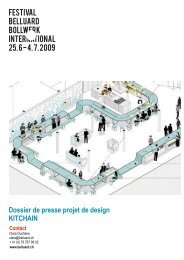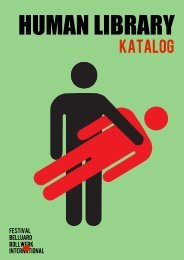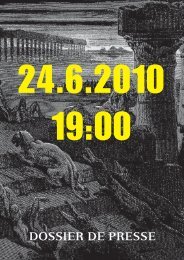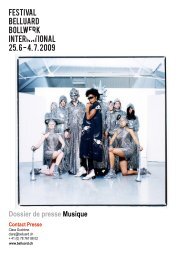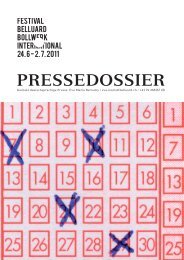DOSSIER DE PRESSE CONTACT PRESSE - Accueil - Festival ...
DOSSIER DE PRESSE CONTACT PRESSE - Accueil - Festival ...
DOSSIER DE PRESSE CONTACT PRESSE - Accueil - Festival ...
You also want an ePaper? Increase the reach of your titles
YUMPU automatically turns print PDFs into web optimized ePapers that Google loves.
THE THEATRE OF VIVARIUM STUDIO<br />
Why is it so disturbing to watch an actor crossing the stage as if he were walking around his own apartment?<br />
Why are we fascinated when we see a dog onstage? Why are we troubled when we can see actors speaking<br />
to one another, but somehow the sound has been turned down too low? Why does the reconstruction of a<br />
miniature forest on stage give us the chills? Why is the presence of a car onstage perceived as a violation of<br />
that space? Put together, these dramatic elements, laid out by Philippe Quesne in the works of the Vivarium<br />
Studio, ably quantify his stagecraft, which, by using a kind of mechanical research, a technical theatre lab<br />
which cleverly modifies the conventions of the genre, generates an ambiguously shaped universe in which<br />
dreams and matter, sound and words, smoke and light, solitude and the group – all mix together. Perfectly<br />
staged, skillfully tuned, the theatre of the Vivarium Studio traces with a logical perspective the turbulences of<br />
an unsettled mind. The interval between a form based on structured thought, articulating clearly and<br />
perceptively the chain of cause and effect – and something formless encompassing possible thought – is what<br />
gives this theatre its strength, reawakening the spectator in another world, as if emerging from some kind of<br />
anesthesia in which he can follow the action without entirely comprehending it. But let us be clear, the works of<br />
the Vivarium Studio, ranging from La Démangeaison des ailes (The Itching of the wings) which is about taking<br />
flight, to L’Effet de Serge (The Serge effect), a strange, false one man show, as well as to D’après Nature<br />
(After Nature), a woodsy equivalent of the aquatic battles fought by the ecologists of Greenpeace on their ship<br />
– do not offer us any facile answers. What they find “playable,” the most optimistic feature of this work, is its<br />
capacity to catapult us into another world, developing simple actions using everyday objects, used in ways that<br />
are clearly outside their -- and our comfort zone. And Serge finds some of its “effects” from inside the world of<br />
childhood. In a cluttered apartment space, the adventure unfolds using car headlights, cardboard boxes,<br />
three flickering magic candles and a little music – yet there are also distress signals which waft toward us in<br />
between the cries of the waves.<br />
The theatre of Philippe Quesne has one fascinating aspect, in that it “stands up,” exactly the opposite of<br />
someone about whom they say, “he can’t stand up any more,” his pieces are curiously focused on the side of<br />
the living, deploying all his strength, his originality and his tension. All of this converges to validate that which<br />
cannot be mastered, creating – along with the evident amusement and the laughs, a sensation of malaise, a<br />
need to ask questions. This experience can be explained because we are used to looking more at the dead.<br />
We even say, “to get inside the skin of the character.” So there’s nothing to worry about in these performances,<br />
as their expiration dates happen to be at the performances’ end. When Philippe Quesne twists our vision,<br />
working with the realism of scenic presence, with the acting of the performers of the Vivarium Studio, an<br />
animal presence, or that of certain elements of nature, our perception is troubled, because the living are<br />
somehow swarming and we are taken aback. These actors overflow what we call the dead stage, adapting<br />
themselves to the space with the<br />
detachment and concentration of someone caught in his own private universe. They’re like extraterrestrials, or<br />
strange ghosts we might glimpse in a far off grotto. The work is thus odd, troubling, but we come back to it<br />
again and again, thanks to Philippe Quesne’s apparent ease in movement and sequencing, highlighting the<br />
concerns we have about our social organisation, about our capacity to be human. To the list of his previous<br />
works, we must add one more, Philippe Quesne’s first theatrical piece was inspired by Maeterlinck’s La Vie<br />
des termites (Life of the termites). Termites are not innocent insects, they can – and do – destroy entire<br />
buildings. The perfection and the efficiency of their organisation is cause for reflection, as they live in a world of<br />
shadows. They are born blind, but this hardly affects or limits<br />
the deleterious impact of their actions.<br />
In the piece D’après Nature (After Nature), the actors repeatedly depict in a tableau a painting by the Flemish<br />
artist Pieter Bruegel, La Parabole des aveugles (The Parable of the blind), which refers to Christ’s parable to<br />
the Pharisees, “if the blind lead the blind, both shall fall into the ditch.” In the tableau six blind characters are<br />
holding each other by the shoulder and all six of them fall, swept along as their guide goes down. They have<br />
their eyes turned up toward Heaven, perhaps appealing for help to their God. Imitating the blind characters of<br />
Bruegel, reconstructing a sort of vivarium of human beings, Philippe Quesne asks, with perfect dramatic effect,<br />
the same question, ”Where will we go if we are merely groping our way and following an incompetent guide ?”<br />
Aude Lavigne (February 2008) Translated from the French by Sara Sugihara.



